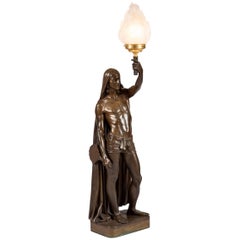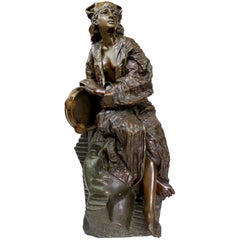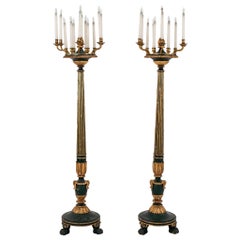A. Toussaint - G. Chaudoir Furniture
Color: Gold
Creator: A. Toussaint - G. Chaudoir
19th Century French Bronze Lamp of Male Indian Figure
By A. Toussaint - G. Chaudoir
Located in London, GB
A well patinated bronze figure, representing an American Indian, wearing a draped headdress, robe and a pendant hooped earring. Signed to the plinth 'A.Tossaint 1850', and the foundr...
Category
19th Century French Anglo-Indian Antique A. Toussaint - G. Chaudoir Furniture
Materials
Bronze
Large 19th Century Pair of Bronze Figural Torcheres
By Ferdinand Barbedienne, A. Toussaint - G. Chaudoir
Located in London, GB
A pair of Figural Porte-Lumières, cast by Barbedienne from the celebrated Armand Toussaint Models
Constructed in bronze, and having a patinated natural, and a highlighted gilt patin...
Category
Mid-19th Century French Romantic Antique A. Toussaint - G. Chaudoir Furniture
Materials
Bronze
Related Items
Gaston Leroux Bronze Figure of Aida on a Sphinx, French, 19th Century
By Gaston Vuevenot Leroux
Located in Los Angeles, CA
Gaston Leroux (French, 1854-1942). A very fine French 19th century polychromed and patinated bronze sculpture of "Aida" resting on a sphinx, her legs crossed and holding a gilt-bronze tambourine, after the model by Gaston Veuvenot Leroux "Aida, A Femme Au Tambourin Assise Sur Une Tete De Sphinx". Signed: Gaston Leroux, Paris, circa 1890.
Measures: Height 29 inches (74 cm).
Width 15 inches (38.1 cm).
Depth 15 inches (38.1 cm).
The opulent and extensively detailed version of Aida was inspired by ethnographic findings of the mid-19th century in ancient Egypt as well as the influences of theatre and costume design. Travelers to the East had often recorded their journeys, either in writing or in pictures, but the movement of Egyptomania was wider-reaching than Egyptology. The immensely popular vogue of Egyptomania is without doubt due to the success of performing arts in recreating this era, in particular, Giuseppe Verdi's Aida. Both the Cairo and Paris premieres created sensations so large that they influenced generations of artists from Alexander Cabanel to Cecil de Mille. In Aida, the ruins of Egypt were brought back to life in full color and scale before the eyes of a generation that would make history as romantics, adventurers and explorers.
The Cairo premier of Aida was entirely conceived by one of the foremost Egyptologists of the day, Auguste Mariette, who was assigned to the project by Khedive Ismail Pasha...
Category
Late 19th Century French Egyptian Revival Antique A. Toussaint - G. Chaudoir Furniture
Materials
Bronze
Pair of 19th Century French Louis XVI Style Torchieres
Located in Houston, TX
Pair of French Louis XVI style candelabra torchieres.
Category
Late 19th Century French Louis XVI Antique A. Toussaint - G. Chaudoir Furniture
Materials
Wood
Pair of Large Patinated Bronze Figural Torcheres Cast by Barbedienne, Dated 1872
By Ferdinand Barbedienne, Émile Guillemin
Located in Brighton, West Sussex
A highly important pair of large patinated bronze figural torcheres by Émile Guillemin, cast by Ferdinand Barbedienne.
French, dated 1872.
Barbedienne Title: 'Deux Femmes, Indi...
Category
Late 19th Century French Antique A. Toussaint - G. Chaudoir Furniture
Materials
Bronze
H 88.98 in W 19.69 in D 29.14 in
Large 19th Century French Grand Tour Bronze Figure of Narcissus
By Fonderia Sommer Napoli
Located in San Francisco, CA
the youth in contrapposto pose with his right arm raised with a goat-skin slung over his left shoulder, his legs slightly apart and wearing sandals. leaning on one hip and looking do...
Category
19th Century Italian Grand Tour Antique A. Toussaint - G. Chaudoir Furniture
Materials
Bronze
Large 19th Century Antique Indian Hindu Ganesha Figural Votive Brass Oil Lamp
Located in Portland, OR
A large antique early 19th century Indian brass votive oil lamp modeled as the Hindu deity, Lord Ganesha, circa 1800.
A finely cast brass figure of Lord ...
Category
Early 19th Century Indian Anglo-Indian Antique A. Toussaint - G. Chaudoir Furniture
Materials
Brass
H 13.5 in W 12 in D 7 in
Pair of French 19th-20th Century Neoclassical Style Cast Iron Figural Torchères
Located in Los Angeles, CA
A very fine pair of French 19th-20th century neoclassical style patinated cast iron figural torchères by A. Durenne, Paris, each representing a figure of a standing young maiden, her arms raised forward while holding a a flaming urn gas light (Now electrified) with a frosted glass flame, each raised on a veined grey marble column stand, both cast-signed 'A. Durenne, Paris'. Antoine Durenne was an internationally renowned French art founder. He attended École Nationale Supérieure des Beaux-Arts in 1842. Durenne purchased a small foundry in Sommevoire, near the Val d'Osne, Haute-Marne, France and established The Durenne firm, circa Paris, 1900.
Cast-iron had been in production during the 18th century but its inferior status to the more fashionable and delicate wrought iron had generally confined its use to architectural work. By the early 19th century, however, rapid developments of the Industrial Revolution combined with the simultaneous burgeoning of a new middle class provided the impetus for a dramatic Expansion in its application and in a short space of time a proliferation of iron foundries across Europe and America thrived on the production of everything from inkstands to railway stations. The use of cast-iron for garden ornament became particularly widespread at this time, as the possibilities for its mass-production at a fraction of the cost of bronze made it the material of choice for outdoor statuary...
Category
Early 1900s French Neoclassical Revival Antique A. Toussaint - G. Chaudoir Furniture
Materials
Marble, Iron
H 71 in W 29 in D 27.5 in
19th Century French Rococo Revival Style Bronze Patinated Dragons Floor Lamp
Located in Plainview, NY
An exceptional late 19th century rare French Rococo revival style floor lamp featuring amazing details. The floor lamp is made of bronze and shows great patina adding Beauty and char...
Category
Late 19th Century Rococo Revival Antique A. Toussaint - G. Chaudoir Furniture
Materials
Bronze
H 72.5 in W 10.5 in D 10.5 in
An Italian 19th Century Patinated Bronze Torchere, After Niccolò Roccatagliata
By Niccolo Roccatagliata
Located in Los Angeles, CA
A Large and Impressive Italian 19th Century Patinated Bronze Figural Torchere, after a model by Niccolò Roccatagliata (Genoa 1593 - Venice 1636). The triangular foot base with projecting putti supporting the stem and oval reserves within cartouche motifs, one containing the initials "S.D" with an olive tree in-between and a bull-head below. The stem knot with figures of winged caryatids and festoons and upper part with cherub heads, acanthus leaves and egg and bead patterns and topped with a later white glass globe. The decorative system refers to the documented artistic production of the Venetian workshop of Niccolò Roccatagliata and takes inspirational model from the base of the Renaissance bronze of the Scuola Grande di San Teodoro in Venice, a work signed by Andrea del Bartolomeo di Alessandri known as Brescianino. Electrified. Circa: Venice, 1850-1880.
RELATED LITERATURE
L. Planiscig, Venezianische Bildhauer der Renaissance, Vienna, 1921, figs. 661-664; C. Avery, 'Andrea del Bartolomeo di Alessandri detto il Bresciano" lavator di gettar di Bronzo": candelabri, satiri e battenti', M. Ceriana and V. Avery (eds.), L'Industria artistica del Bronzo del Rinascimento a venezia e nell'Italia settentrionale, Venice, 2008, pp. 233-252.
Similar models of this torchere were part of the interior decor collection at the Vanderbilt Mansion in New York (see black and white photo). The Cornelius Vanderbilt II House was a large mansion built in 1883 at 1 West 57th Street in Manhattan, New York City. It occupied the frontage along the west side of Fifth Avenue from West 57th Street up to West 58th Street at Grand Army...
Category
19th Century Italian Baroque Antique A. Toussaint - G. Chaudoir Furniture
Materials
Bronze
H 66.5 in W 19.25 in D 18 in
French 19th Century Bronze Military Figure of "Blandan" after Jean Gautherin
By Jean Gautherin
Located in Los Angeles, CA
A very fine French 19th century patinated bronze figure of the French hero of the Algerian conquest, Jean-Pierre Hippolyte Blandan (1819-1842) after the French Sculptor Jean Gautheri...
Category
19th Century French Louis Philippe Antique A. Toussaint - G. Chaudoir Furniture
Materials
Bronze
H 31.5 in W 17.25 in D 11.25 in
French 19th Century Bronze Figure of Venus De Milo
Located in London, GB
A late 19th century French bronze model of the Venus de Milo
We can assure you if your looking for one of these bronzes this is the highest quality casting.
This is presented on a ...
Category
1880s French Antique A. Toussaint - G. Chaudoir Furniture
Materials
Bronze
Pair of French Belle Époque 19th-20th Century Gilt Bronze and Alabaster Torchere
Located in Los Angeles, CA
A palatial pair of French Belle Époque 19th-20th century gilt bronze and alabaster tall torchières. The slender center column raised on a circular intri...
Category
Early 1900s French Belle Époque Antique A. Toussaint - G. Chaudoir Furniture
Materials
Alabaster, Bronze
Pair 19th Century Japanese Imari Porcelain & Gilt-Bronze Torchere Candelabra
By Imari Porcelain
Located in Los Angeles, CA
A fine Pair of 19th century Japanese Imari Porcelain and French Gilt-Bronze Mounted Thirteen-Light Celadon Torchere Candelabra. The bottle-shaped Japonisme vases with a Royal red background, decorated with parcel-gilt and black soaring eagles in the hunt within a forestall scene. Each Vase fitted and surmounted with a French 19th century Louis XV Style 13-Light scrolled candelabrum and all raised on a circular pierced gilt-bronze plinth. circa: 1880.
Imari Porcelain (????) is the name for Japanese porcelain wares made in the town of Arita, in the former Hizen Province, northwestern Kyushu. They were exported to Europe extensively from the port of Imari, Saga, between the second half of the 17th century and the first half of the 18th century. The Japanese as well as Europeans called them Imari. In Japanese, these porcelains are also known as Arita-yaki (???). Imari or Arita porcelain has been continously produced up through the present day.
Characteristics
Though there are many types of Imari, Westerners' conception of Imari in the popular sense is associated only with a type of Imari produced and exported in large quantity in mid-17th century. This type is called Kinrande. Kinrande Imari is colored porcelain with cobalt blue underglaze and red and gold overglaze. The color combination was not seen in China at that time. Traditional Ming dynasty color porcelain used dominantly red and green, probably due to scarcity of gold in China, whereas gold was abundant in Japan in those days. The subject matter of Imari is diverse, ranging from foliage and flowers to people, scenery and abstractions. Some Imari design structures such as kraak style were adopted from China, but most designs were uniquely Japanese owing to the rich Japanese tradition of paintings and costume design. The porcelain has a gritty texture on the bases, where it is not covered by glaze. There is also blue and white Imari. Kakiemon style Imari is another type of Imari, but it tends to be categorized separately in Europe.
History
"Imari" was simply the trans-shipment port for Arita wares. It was the kilns at Arita which formed the heart of the Japanese porcelain industry.
Arita's kilns were set up in the 17th century, when kaolin was discovered in 1616 by the immigrant Korean potter, Yi Sam-pyeong (1579–1655). (He may also be known by the name, "Kanage Sambei".) Yi Sam-Pyeong, along with his extended family of 180 persons, left Korea on the offer of a privileged position in Japan. This decision was made after the occurrence of certain Japanese invasions of Korea. After Yi Sam-Pyeong's discovery, his kilns began to produce revised Korean-style blue and white porcelains, known as "Shoki-Imari".
In the mid-17th century there were also a lot of Chinese refugees in Northern Kyushu due to the turmoil on Chinese continent, and it is said one of them brought coloring technique to Arita. Thus Shoki-Imari developed into Ko-KutaniImari. Ko-Kutani was produced around 1650 for both export and domestic market. Blue and white porcelain continued to be produced and they are called Ai-Kutani. Ko-Kutani Imari for the export market usually adopted Chinese design structure such as kraak style, whereas Ai-Kutani for the domestic market were highly unique in design and are accordingly valued very much among collectors.
Ko-Kutani style evolved into Kakiemon style Imari, which was produced for about 50 years around 1700. Imari achieved its technical and aesthetic peak in Kakiemon style, and it dominated European market. Blue and white Kakiemon is called Ai-Kakiemon. Kakiemon style transformed into Kinrande in the 18th century. Kinrande used blue underglaze and red and gold overglaze, and later some other colors.
Imari began to be exported to Europe because the Chinese kilns at Ching-te-Chen were damaged in the political chaos and the new Qing dynasty government stopped trade in 1656–1684. Exports to Europe were made through the Dutch East India Company, but the designation "Imari Porcelain" in Europe connotes Arita wares of mostly Kinrande Imari.
Export of Imari to Europe stopped in mid-18th century when China began export to Europe again, since Imari was not able to compete against China due to high labor cost. By that time, however, both Imari and Kakiemon style were already so popular among Europeans, Chinese export porcelain copied both Imari and Kakiemon style, which is called Chinese Imari. At the same time, European kilns, such as Meisen also tried to copy Imari and Kakiemon.
Export of Imari surged again in late 19th century (Meiji era) when Japonism flourished in Europe. Thus in western world today, two kinds of Imari can...
Category
19th Century Japanese Japonisme Antique A. Toussaint - G. Chaudoir Furniture
Materials
Ormolu, Bronze
A. Toussaint - G. Chaudoir furniture for sale on 1stDibs.
A. Toussaint - G. Chaudoir furniture are available for sale on 1stDibs. These distinctive items are frequently made of metal and are designed with extraordinary care. There are many options to choose from in our collection of A. Toussaint - G. Chaudoir furniture, although gold editions of this piece are particularly popular. If you’re looking for additional options, many customers also consider furniture by Thiebaut Freres, Jean Alexandre Joseph Falguière, and Christopher Fratin. Prices for A. Toussaint - G. Chaudoir furniture can differ depending upon size, time period and other attributes — on 1stDibs, these items begin at $18,931 and can go as high as $154,843, while a piece like these, on average, fetch $86,887.



